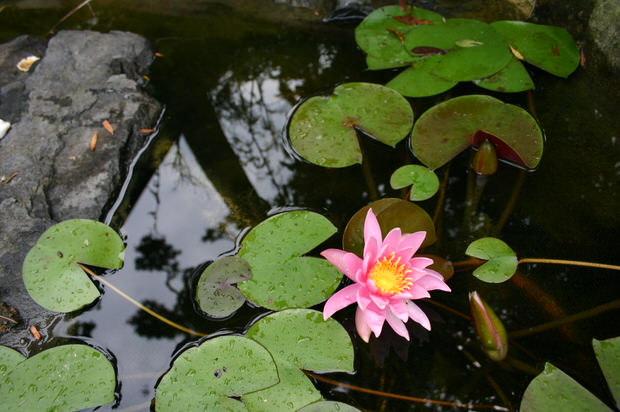






Water gardens, also known as aquatic gardens and garden ponds, are miniature ecosystems. They add charm, enthusiasm and a sense of tranquility to any place.
Water gardens can be created by combining a pool with aquatic plants and ornamental fish. Rocks, waterfalls etc when combined with pools add to the beauty of the gardens. Water gardens can be man-made or natural, comprising the right blend of flora (plants) and fauna (animals).
Pond Plants
Water gardens have plants such as submerged plants, marginal plants and floating plants. Submerged plants are those that grow completely under water. Marginal plants have their roots deep into the soil but the plant grows above the surface of water. Floating plants grow freely floating on the water surface. The submerged plants in the ponds often act as oxygenators and provide oxygen to the fish in ponds. A garden pond requires at least one oxygenator and a lily plant.
Aquatic Animals
Water gardens look colorful with fish like Koi, Gold Fish, Golden Orfe, Golden Tench, Mosquito Fish etc. Water ponds also attract snails, frogs and other predators. Some predators such as snakes can be dangerous to the fish in the pond.
Requirements For Water Gardens
There are certain points that need to be considered when installing water gardens. Some of them are –
1. Sunlight – Most water plants need enough sunlight to grow. Hence it is recommended to install the water pond at a place where there is enough sunlight. In case of shadier places, the choice of plants is limited.
2. Trees – Having a water pond near a tree is not preferable. The dried leaves from the tree may fall into the water and harm the aquatic plants and animals.
3. Location – The location of a garden pond should be such that it can be easily viewed and enjoyed. It is recommended to install it in places near the windows or in places easily viewable from the terrace etc.
4. Size – Size of the water garden should suit the size of the garden. A small garden will not look good with a large water pond.
Maintenance of A Water Garden
Since the garden ponds contain plants and animals living in them, just creating water gardens is not enough. They require regular maintenance. Maintenance of ponds includes filtering the water, pumping, preventing the formation of algae etc.
Equipments Used For Maintenance Of Water Gardens
Pond Pumps – Pond pumps provide water enriched with oxygen to the plants and animals in the pond. While choosing a pond pump do consider the operating cost of the pump as well along with the pump cost.
Pond Filters – Pond filters mainly function to filter the water in the pond. Fish and other aquatic animals living in water pollute the water due to their regular metabolic activities. If the impurities are left behind, the water gets polluted thereby causing harm to the plants and animals in the pond.
Ultraviolet clarifier – Ultraviolet clarifier (UVC) is used to prevent algae that result in green murky water. The algae remove the oxygen from pond water and hence may cause death of fish in the pond. UVCs are usually included in most pond filters. It is important to note that UVC contains quartz tubes since that doubles the efficiency of the UVC.
With proper planning and maintenance, water gardens can be your source of joy and pride.
Article by GardeningToolsAdvice.com. Get all of the latest in water gardens know how from the one and only true gardening resource at http://www.gardeningtoolsadvice.com
Tips for Maintaining Lawn and Garden Equipment in Winter
Tips for maintaining marble flooring
Tips for Maintaining Your Hot Tub
Deep Water Aquatics For A Pond
Water Fountains For Relaxation And Fun
Gardening Tips For Green Thumbs And Newbies Alike
Colonial Garden Plants: Tips For Growing And Designing Colonial Period Gardens
Copyright © www.100flowers.win Botanic Garden All Rights Reserved